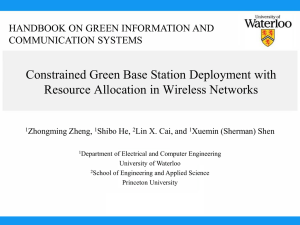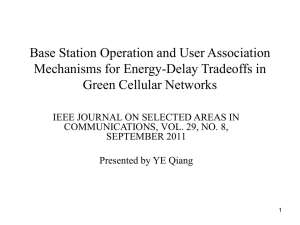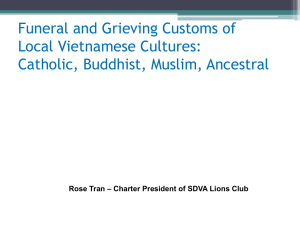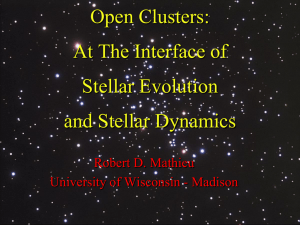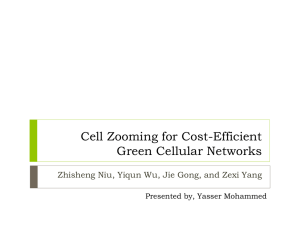S0-Cannon
advertisement
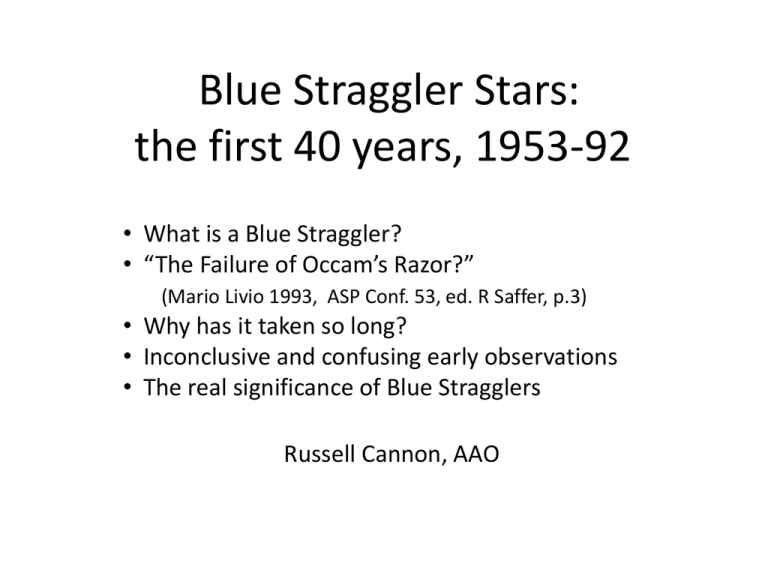
Blue Straggler Stars: the first 40 years, 1953-92 • What is a Blue Straggler? • “The Failure of Occam’s Razor?” (Mario Livio 1993, ASP Conf. 53, ed. R Saffer, p.3) • Why has it taken so long? • Inconclusive and confusing early observations • The real significance of Blue Stragglers Russell Cannon, AAO Sandage’s first M3 CMD Sandage A R 1953, AJ 58 61 Sandage’s first M3 CMD Sandage A R 1953, AJ 58 61 The “Classical” Blue Stragglers • Stars which lie on or near the Main Sequence in a star cluster, but above the turn-off point o Apparently younger or rejuvenated stars, but not a simple second population o Not part of the Horizontal Branch o Not simply unresolved binaries o Hard to define in the general field o Later based on X-ray sources and pulsars Some key resources • Blue Stragglers: STScI Workshop, Oct 1992 (ASP Conf. 53, ed. R A Saffer, 1993) – esp. M Livio, p.3 and V Trimble, p.155 • Hut P et al. 1992, Binaries in Globular Clusters PASP 104 981, based on an informal meeting • Stryker L 1993, BSs review, PASP 105 1081 • Bailyn C D 1995, BSs and Dynamics of GCs, ARA&A 33 133 An aside on ROB 82 • Royal Observatory Bulletin No. 82, 1964 gives a verbatim account of an IAU Colloquium on “Star Clusters and Stellar Evolution”, held at the Royal Greenwich Observatory while it was in Sussex, in August 1962. • It is one of several early references to BSs that are in obscure places and often not available through the ADS. • Pages 89-92 contain a discussion on “blue stars”, involving McCrea, Sandage, Hoyle, Eggen, Schwarzschild, Herbig, Stromgren, Blaauw and Woolley. … and some telling quotes • “The few blue stragglers in M67 are usually dismissed – M67 would then make a perfect model for Baade’s Galactic Centre Population” (Hyron Spinrad 1966, PASP 78 367 • “Blue stragglers remain one of the unexplained oddities of astronomical lore” (Craig Wheeler 1979, ApJ 234 569) • “All in all, blue stragglers seem to be both inadequately understood and insufficiently appreciated” (Virginia Trimble 1992, PASP 104 p. 4) • “Progress has certainly been made in the last 40y, but BSs remain an intriguing challenge.” Stryker, 1993 • “… every kind of object … can be made in at least two different ways, all of which are likely to be significant …” Bailyn, 1995 • “Efforts to provide simple explanations for the full range of observed phenomena appear doomed to failure.” Bailyn, 1995 CMD for the old Open cluster M67 Johnson H L & Sandage A R 1955, ApJ 121 616 An improved CMD for M67 Eggen O J & Sandage A R 1964, ApJ 140 130 BSs in the old open cluster M67 F81 Eggen O J & Sandage A R 1964, ApJ 140 130 Early theories for BSs (see Livio, 1993) • Binary stars? – All probably occur – Algol-type mass exchange – Merged binaries – Stellar collisions • Single stars? – Mostly discredited, or rare – Delayed or late star formation – Fully mixed stars – Tidally captured stars – Bondi-Hoyle accretion from ISM A personal (British) perspective on BSs • Similar to Algol-type eclipsing binaries • Germ of idea planted by Fred Hoyle – Frontiers of Astronomy, 1955, Heinemann – Probably due to Crawford, 1955 ApJ 121 71 • Developed for BSs by McCrea, 1964 (MN 128 147) • One aim of my PhD was to understand BSs in old Open clusters. Early NGC 188 CMD CMD of NGC 188 bright proper motion members Cannon 1968, PhD Radial distribution of Blue Stragglers and Red Giants in NGC 188 Solid histograms for cluster members, dashed lines field stars. Upper panel for BSs, lower panel for red giants Blue Stragglers in 5 old open clusters A composite absolute CMD for proper motion members Nearly all BSs lie between the ZAMS and the blue side of the Hertzsprung Gap. There is no obvious connection with the globular cluster HB. BSs relative to cluster MSTO CMD for BSs relative to m.s. turn-off in 5 old open clusters NGC 7789, NGC 188, M67, NGC 6939 and NGC 752 Toy models for mass exchange binaries Note that there is a lower limit for BSs resulting from mass exchange in binary systems, but not for direct collisional mergers. The curious case of NGC 6791 Kinman T D 1965, ApJ 142 655 NGC 6791 Schematic CCD CCD CMD for NGC 6791 Montgomery K A, Janes K A & Phelps R L 1994, AJ 108 585 (p.m. members Cudworth K 1994; cf Kaluzny J 1990) What is NGC 6791, as seen in 2012? • • • • • • • • • Globular or old Open cluster? 25 published papers in 2011-12 (ADS) Happens to be in the Kepler field Age ~ 8 Gy, [Fe/H] ~ +0.4: unique such cluster Multiple populations from CN/CH and Na/O Has binaries, incl. BSs Also contains hot Blue Horizontal Branch stars Asteroseismology: core masses and mass loss On borderline between GC and OC 425 BSs in 21 Globular Clusters Fusi Pecci F et al 1992, AJ 104 1831 409 BSs in 22 globular clusters Sarajedini A 1993, ASP Conf 53 14 More BSs in M3 Fusi Pecci, Ferraro & Cacciari 1993, ASPConf 53 97 Evidence for two or more BS formation mechanisms in GCs • Spatial distribution (e.g. in M3, Fusi Pecci, Ferraro & Cacciari, 1993) • HST discoveries in the cores of dense clusters • A mix of primordial binaries, with mass exchange or coalescence • And collisions in dense cores, which may both create and destroy multiple star systems (as well as solving the core collapse dynamical problem) Environmental effects in GCs – are we being misled? • We now realise that stars in clusters are neither chemically homogeneous nor coeval • There is interdependence between stellar evolution and cluster dynamics • Stellar evolution has been fine-tuned to fit star clusters, esp. globulars • There are still major gaps in standard evolutionary theory (e.g. AGB mass loss) More on Open clusters • I have ignored the important early work of Ed van den Heuvel, showing that Ap and Am stars in younger open clusters are classical BSs (e.g. van den Heuvel 1968, BAN 19 326) • Mario Mateo gave a good review of work on variable stars, both physical and eclipsing, at the 1992 STScI workshop Light curve for NJL 5 in ω Cen Jensen K S & Jorgensen H E 1985, A&A Supp 60 229 NJL = Niss B, Jorgensen H E & Laustsen S 1978, A&AS 32 387 NJL 5 radial velocity curve (1988) Small dots: CTIO (Margon) Large: AAT (Cannon & Stathakis) Why we failed with NJL 5 • At ~16 mag, it is one of the brightest BSs in ω Cen but still faint for a 4m in poor weather • We hoped to see double lines, to derive masses • Complicated to schedule the observations • The Calcium triplet lines land on top of hydrogen Paschen lines in the near IR • “We are currently obtaining the necessary spectroscopy at much higher resolution to determine the orbital parameters of NJL 5” Pros and cons for BSs in Open Clusters • • • • • Small sample of older OCs Few BSs in each cluster Cluster membership? Reddening and dust? Confusion with BHB stars in oldest Ocs • Nearer, with brighter stars • N-body modelling easier for 1000s of stars Some practical difficulties • For Open clusters, it is still surprisingly difficult to get very precise photometry or positions (for proper motions) across fields of view of 12 degrees • In Globular clusters, it is hard to get comparable data for stars in dense cores and sparse outer regions Future prospects • GAIA (distances and proper motions) • Near IR spectroscopy (better abundances) • Asteroseismology (cores in red giants) • We should be able to model many BSs • Predicting the existence of BSs, and their effect on the integrated spectra of high redshift galaxies, may take a little longer



